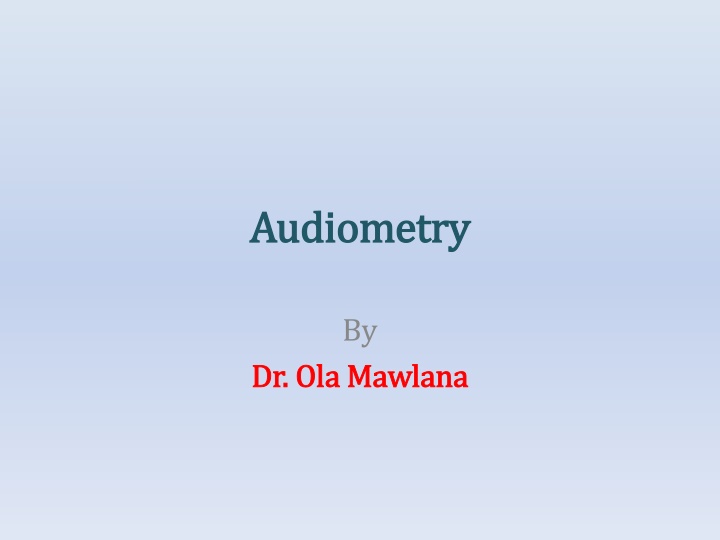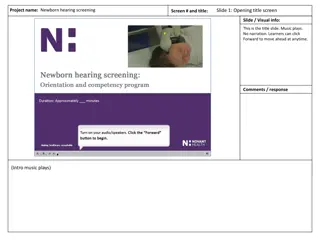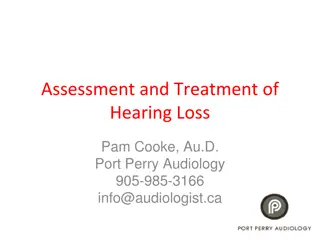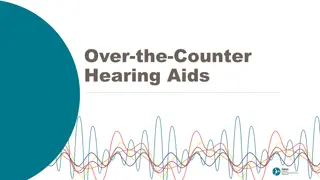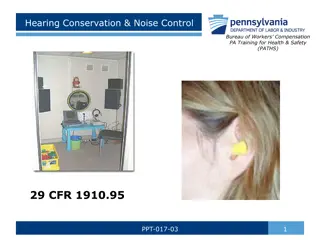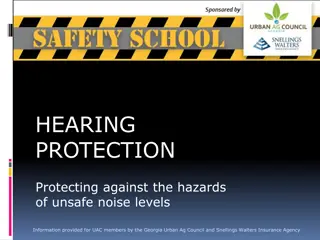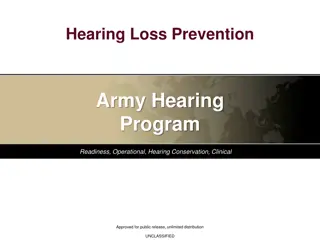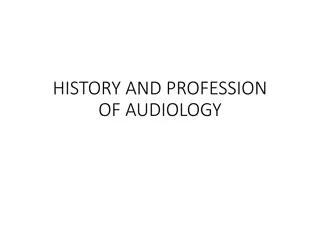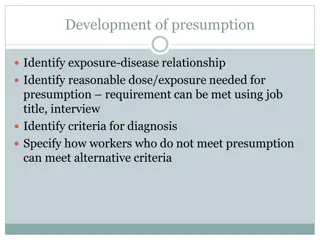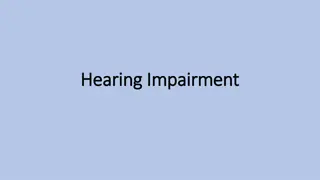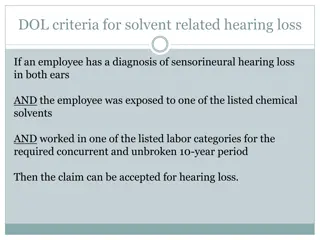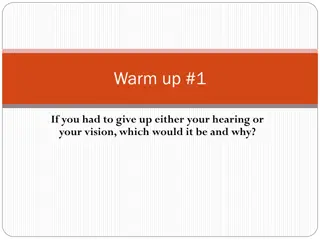Fundamentals of Audiometry: Understanding Hearing Loss and Diagnostic Tests
Explore the basics of audiometry, including air and bone conduction tests, masking sounds, pure tones, and audiograms. Learn how audiometry helps in determining hearing loss type, degree, and configuration. Enhance your knowledge of tuning fork tests and interpreting audiograms to evaluate auditory function effectively.
Uploaded on Oct 10, 2024 | 0 Views
Download Presentation

Please find below an Image/Link to download the presentation.
The content on the website is provided AS IS for your information and personal use only. It may not be sold, licensed, or shared on other websites without obtaining consent from the author.If you encounter any issues during the download, it is possible that the publisher has removed the file from their server.
You are allowed to download the files provided on this website for personal or commercial use, subject to the condition that they are used lawfully. All files are the property of their respective owners.
The content on the website is provided AS IS for your information and personal use only. It may not be sold, licensed, or shared on other websites without obtaining consent from the author.
E N D
Presentation Transcript
Audiometry Audiometry By Mawlana Dr. Ola Dr. Ola Mawlana
Objectives Objectives At the end of the session, students should be able to: Determine the type, degree, and configuration of hearing loss. Describe the techniques of Tuning fork tests. Plot the frequency-intensity recording and construct the audiograms. Interpret the audiograms.
Air conduction Air conduction This test assesses the transmission of sound waves through air to the auditory cortex via auditory nerve involving outer, middle and inner ears. The sound is amplified 22 times when it is transmitted through air conduction by the tympanic membrane (17 times) and the ossicles (1.3 times). That is why, air conduction is always better than bone conduction in a normal person.
Bone conduction Bone conduction This test assesses the transmission of sound waves through the bones of the skull to the cochlea and then through the auditory pathways to the auditory cortex, bypassing the outer and middle ears.
Masking sound Masking sound Masking sound is the sound present in the background that interferes with the sound that we want to listen. It is provided constantly to the right ear during the whole audiometry procedure if the left ear is tested so that whatever pure tone is given to the left ear is heard only by the left ear, because the right ear will be busy listening to the masking sound. In the same way, the masking sound will be provided to the left ear, if the right ear is tested.
Pure tone Pure tone A pure tone is a single frequency tone with no harmonic content (no overtones). This corresponds to a sine wave.
Audiogram Audiogram An audiogram is a chart of hearing sensitivity with the frequency of sound plotted on the X- axis and the intensity of sound on the Y-axis. Intensity (loudness) is the level of sound power measured in decibels and frequency (pitch) is the number of sound waves per second measured in Hertz.
Pure Tone Audiometry Pure Tone Audiometry Audiometry is the measurement of hearing using an audiometer. An audiometer is an electronic device that produces acoustic stimuli of known frequency and intensity for the measurement of hearing. Earphone (red and blue) used to test air conduction - Vibrator (bone) is for testing bone conduction
P Procedure rocedure 1. The subject is seated comfortably in a sound proof room. 2. Color-coded earphones are applied (Red for right ear, Blue for left ear). 3. Each ear is tested at a time. 4. Masking sound is delivered to the non-test ear. 5. The ear being tested will be presented with pure tones of varying frequencies. 8 to10 frequencies covering the auditory spectrum are usually tested and the hearing loss is determined for each of these frequencies. 6. The examiner starts testing with a tone of 0 dB at 125 Hz. Then gradually increasing the frequency to 250 Hz, 500 Hz, 1000 Hz, 2000 Hz, 4000 Hz, and 8000 Hz, however keeping the tone at 0 dB. If any of the frequencies was not heard we move to a louder tone and repeat the process again.
Cont. 7. The responses are plotted on the audiogram. 8. This tests air conduction of the subject and the plotted marks are joined to produce the curve for air conduction. 9. The same steps are then repeated with the electronic (bone) vibrator on the mastoid process to test for bone conduction. 10. The responses are plotted on the audiogram as well using a different symbol. 11. The audiogram then will give a measure of the hearing threshold of the subject showing the presence of any hearing loss. It will also show the frequencies affected. Comparing air conduction with bone conduction, gives important clues as to the cause of hearing loss. 12. Normally air conduction is better than bone conduction.
Degree of hearing loss Degree of hearing loss
Conductive hearing loss Conductive hearing loss Conductive deafness reduces the effective transmission of sound through air conduction, but it does not affect bone conduction. Conductive deafness is transmission in the external or middle ear. Patients with conductive deafness show better bone conduction compared to air conduction due to loss of sound amplification. due to impaired sound
C Causes auses Causes of conductive deafness include - Wax in the ear canal - Ruptured tympanic membrane, - Fluid in the middle ear system (otitis media) - Fixation of the footplate of stapes to the oval window (Otosclerosis)
Sensorineural hearing loss Sensorineural hearing loss Sensorineural hearing loss occurs when there is damage to the inner ear (cochlea), or to the nerve pathways from the inner ear to the brain. Sensorineural hearing loss reduces the ability to hear faint sounds. Even if speech is loud enough to hear, it may sound unclear or muffled to a person with sensorineural hearing loss. The audiogram of a person with sensorineural hearing loss will show a decrease or a total loss of hearing for both air and bone conduction. This decreased or lost hearing may affect all frequencies or may be confined to certain frequencies, e.g. only with high frequencies or only with low frequencies.
Causes Causes Causes of sensorineural hearing loss may be congenital or acquired. Acquired causes for sensorineural hearing loss my include - Degenerative diseases such as presbycusis - Trauma such as noise and head injury - Idiopathic e.g. Meniere's disease - Ototoxicity secondary to drugs like aminoglycosides and salicylates. - Tumors such as acoustic neuroma.
Mixed hearing loss Mixed hearing loss Sometimes combination with a sensorineural hearing loss. In other words, there may be damage in the outer or middle ear and in the inner ear (cochlea) or auditory nerve. When this occurs, the hearing loss is referred to as a mixed hearing loss. The audiogram shows a mixed picture of both patterns. a conductive hearing loss occurs in
Mixed hearing loss Mixed hearing loss
Air conduction in different cases Air conduction in different cases
Rinnes test Rinne s test This test compares air conduction with bone conduction Procedure: Procedure: 1. Strike a 512 Hz tuning fork softly on the palm to produce vibration. 2. Place the vibrating tuning fork on the base of the mastoid bone. 3. Ask the subject to tell you when the sound is no longer heard. 4. Immediately bring the tuning fork just in front of the ear. 5. Ask the subject to tell you whether he still hears it or not.
Interpretation Interpretation Normal subjects will hear sound through air conduction twice as long as bone conduction. They will still hear it in front of the ear when they can t hear anymore from the base of the mastoid bone. With With conductive conductive deafness deafness, bone conduction will be better than air conduction. In this case, when the subject stops hearing sound from the mastoid bone and brings the tuning fork in front of the ear, he will not hear any sound there too. With With sensorineural sensorineural deafness deafness, the sound through air conduction is heard longer than bone conduction in affected ear, but less than twice longer as is the case in normal subjects.
Webers Test Weber s Test This test distinguishes between conductive and sensorineural deafness Procedure Procedure 1. Strike a 512 Hz tuning fork softly on the palm to produce vibration. 2. Place the vibrating tuning fork on the vertex of the subject. 3. Ask the subject if the sound is heard better in one ear or the same in both ears.
Interpretation Interpretation If hearing is normal, the sound will be heard equally in both ears. The sound is heard better in the affected or diseased ear in a subject with conductive deafness because of the loss of masking effect of the environment and all the receptors for hearing in the affected ear are free to hear the sound. The sound is obviously heard better in the normal ear than the affected ear in a subject with sensorineural deafness because the cochlea and the neural pathway is intact on the normal side.
Tuning fork hearing tests. (A) Rinne's test, (B) Weber's test.
